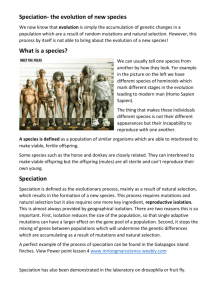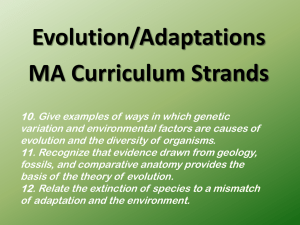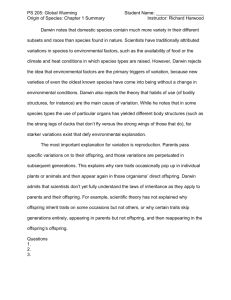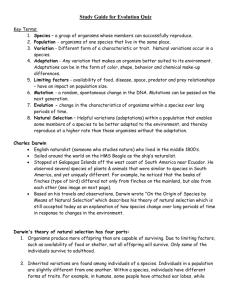Dumb King Phillip Came Over For Great Spaghetti *Domain
advertisement
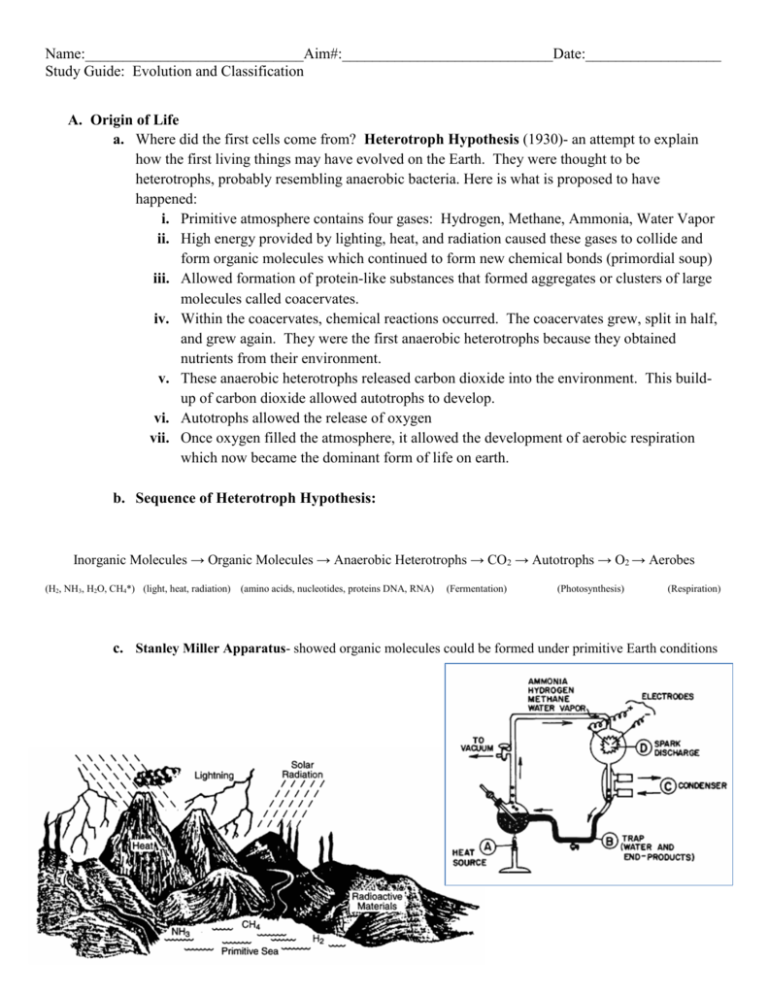
Name:_____________________________Aim#:____________________________Date:__________________ Study Guide: Evolution and Classification A. Origin of Life a. Where did the first cells come from? Heterotroph Hypothesis (1930)- an attempt to explain how the first living things may have evolved on the Earth. They were thought to be heterotrophs, probably resembling anaerobic bacteria. Here is what is proposed to have happened: i. Primitive atmosphere contains four gases: Hydrogen, Methane, Ammonia, Water Vapor ii. High energy provided by lighting, heat, and radiation caused these gases to collide and form organic molecules which continued to form new chemical bonds (primordial soup) iii. Allowed formation of protein-like substances that formed aggregates or clusters of large molecules called coacervates. iv. Within the coacervates, chemical reactions occurred. The coacervates grew, split in half, and grew again. They were the first anaerobic heterotrophs because they obtained nutrients from their environment. v. These anaerobic heterotrophs released carbon dioxide into the environment. This buildup of carbon dioxide allowed autotrophs to develop. vi. Autotrophs allowed the release of oxygen vii. Once oxygen filled the atmosphere, it allowed the development of aerobic respiration which now became the dominant form of life on earth. b. Sequence of Heterotroph Hypothesis: Inorganic Molecules → Organic Molecules → Anaerobic Heterotrophs → CO2 → Autotrophs → O2 → Aerobes (H2, NH3, H2O, CH4*) (light, heat, radiation) (amino acids, nucleotides, proteins DNA, RNA) (Fermentation) (Photosynthesis) (Respiration) c. Stanley Miller Apparatus- showed organic molecules could be formed under primitive Earth conditions Name:_____________________________Aim#:____________________________Date:__________________ Study Guide: Evolution and Classification B. Evolution a. Change in living things (populations) over time. Living things have evolved from common ancestors. Many life forms that once existed on the Earth are now extinct. i. Modern day evolution in action- Bacteria can become resistant to antibiotics, insects can become resistant to insecticides, and viruses can become resistant to antiviral drugs. b. Extinction- when all members of a species dies out. 99% of all the species that have lived on the Earth have become extinct. c. Theories: i. Lamarck- Proven Wrong!!!! 1. Theory of Need, Use and Disuse, and passing acquired characteristics to offspring. Was disproved by Weissman, who cut the tails off of mice for many generations, only for the offspring to be born with tails. a. We do not develop adaptations because we need them!!! b. Acquired characteristics are not passed to offspring!!! ii. Darwin’s Theory of Origin of Species through Natural Selection 1. Trip on the HMS Beagle, to study plants and animal of Galapagos Islands. a. Basic Principles: i. Overproduction of offspring ii. Competition iii. Variations exist in the species iv. Survival of the fittest v. Natural Selection b. Could not explain how variations occurred. (didn’t know about genetics, DNA, crossing over, sexual recombination, mutations, and migrations of genes into and out of populations) iii. Modern Evolutionary Theory- Darwin + Genes (explains variations) 1. Gene Pool- all the genes in a population 2. Evolution occurs because gene pools change over time. 3. Variations occur because of gene mutations, chromosomal mutations, polyploidy (plants), sexual recombination that can occur during sexual reproduction, or even migrations into and out of the population. d. Adaptation-a trait that you are born with that enhances your chance of survival i. Mutations- are not caused by environmental changes; mutations are random 1. Beneficial mutations- allow you to survive longer, reproduce more, and therefore are passed on to next generation 2. Negative mutations- usually cause an organism to die, and do not get passed on 3. Positive traits- increase in a population/ negative traits- decrease in a population Name:_____________________________Aim#:____________________________Date:__________________ Study Guide: Evolution and Classification e. Geographic isolation (a type of isolation where a population is separated by geography) → Reproductive Isolation (members of original population can no longer mate to produce fertile offspring) → Speciation (new species occurs) i. Why can they no longer mate? 1. Changes in reproductive cells, reproductive behaviors, etc. f. Rates of Evolution i. Gradualism- evolution of a species occurs in a slow, steady pace over a very long period of time (unfortunately, not too much proof for this in the fossil record) ii. Punctuated Equilibrium- evolution of a species occurs in uneven intervals; long periods of stability, followed by major changes in species, triggered by either some massive mutation or some catastrophic event. g. Evidence for Evolution i. Fossil Record ii. Comparative biochemistry (DNA, ATP, Proteins) iii. Homologous structures iv. Comparative embryology v. Comparative cytology (cells) vi. Vestigial organs h. Hardy-Weinberg- proposed that evolution could theoretically be stopped if 5 conditions were met: i. Large population ii. No mutations iii. No migrations into or out of the population iv. No natural select v. Random mating 1. It is impossible to meet all of these conditions, therefore evolution can not be stopped! Name:_____________________________Aim#:____________________________Date:__________________ Study Guide: Evolution and Classification C. Classification a. Taxonomy- the study of classification b. Organisms are classified into groups based on SHARED CHARACTERISTICS c. Carl Linneaus- the Father of Classification d. Binomial Nomenclature- 2-name system (Genus + species) Ex. Common Dog - Scientific Canis familiaris Cat - Felis domesticus Human - Homo sapiens *Dumb King Phillip Came Over For Great *Domain Kingdom Phylum Class Order Family Genus Spaghetti Species ~ Most General:____________________________ ~ Most Specific:____________________________ e. Kingdoms: Prokaryotic: Archaeabacteria Eukaryotic: Protist - Fungi Eubacteria Plant Animal Advantage of 5 kingdom system: evolutionary relationships become evident f. Species- a group of organisms that can reproduce fertile offspring (ex. Dog breeds vs. Horse and Donkey) D. Labs a. Geologic Timeline- even though Earth is about 4.6 BY old, the real explosion of multicellular lifeforms has occurred within the last 600 million years. Man is a relative youngster having evolved only about 2 mya. b. Adaptive Radiation- common ancestor could “radiate/diverge” out to form many different species. Each one is well adapted to fit into its environment. Often when catastrophic events occur, many species die off and leave many available niches that can be filled in by a species that is undergoing adaptive radiation c. Hawk/Geographic Isolation- When a population of animals or plants are separated by a geographic barrier (geographic isolation) and wind up in different envirnoments, these now separated populations will evolve differently. If this geographic isolation continues for a long period of time, so that the populations can not interbreed, reproductive isolation will result. After a long period of time, the populations can not mate together to form a “fertile offspring” and speciation (new species) will result. (Think: Galapagos finches) Name:_____________________________Aim#:____________________________Date:__________________ Study Guide: Evolution and Classification d. Beak of Finches Lab- the environment (the seeds on the island) can act as a selecting agent on the variations that exist within a population (different beaks) i. Make sure you understand the Galapagos Beaks chart which shows the beaks and the food that each finch will successfully eat ii. Lab shows Darwin’s theory of natural selection 1. Birds overproduce 2. Variations among the birds (different beak shapes and sizes) 3. Struggle to survive (trying to get food) 4. Survival of the fittest (bets beaks get to 13 seeds) 5. Fittest will pass along their favorable trait (great beak) and over time they will become a new species e. Dichotomous Key i. The many living species that live on the Earth need to be identified ii. A dichotomous key is a series of paired statements that help to identify an organism iii. Be able to use a dichotomous key to identify organisms AND be able to construct a simple dichotomous key (see next page) Name:_____________________________Aim#:____________________________Date:__________________ Study Guide: Evolution and Classification State some conclusions you could draw from the family tree of the modern horse to the left.

